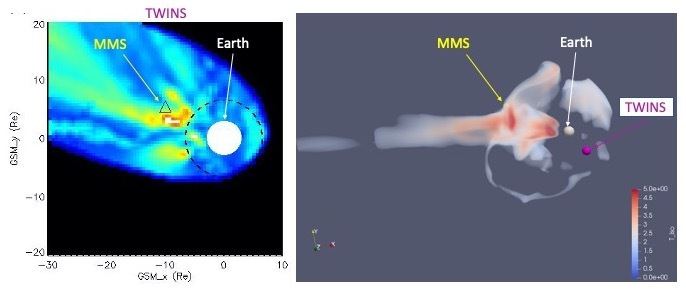By Mara Johnson-Groh
NASA’s Goddard Space Flight Center
Up in the night sky, above the auroras and below the Moon, there exists a heated superhighway. Instead of cars though, this transient highway funnels charged particles across hundreds of thousands of miles toward Earth for a few minutes before vanishing.
While we can’t see it with our eyes, scientists have recently discovered a new way to look at the entire transportation structure from afar for the first time using special particles called energetic neutral atoms. Ultimately, this could help scientists predict when dangerous effects of space weather might be headed towards Earth.

Credit: Amy Keesee/University of New Hampshire
The highway is temporarily created within Earth’s self-generated magnetic bubble, during periods of intense activity from the Sun, when the planet is bombarded with charged particles and radiation. The bubble protects the planet from most of the particles, but some sneak through and are funneled along towards Earth along a highway-like structure.
Since these particles can disrupt satellites and telecommunications in space and damage systems on Earth, scientists are keen to study how they are transported. However, charged particles have to be measured where they are – rather than being tracked with far-away observatories. This is like monitoring traffic by standing right on a highway instead of from a helicopter flying above – which makes it hard to get a full picture of the routes the vehicles travel.
As a result, scientists have only been able to glimpse snapshots of particles’ paths as satellites passed through the region.
But recently a group of scientists, led by Amy Keesee, a space physicist at the University of New Hampshire, decided to look at the highway in a new way. Using data from NASA’s Two Wide-angle Imaging Neutral-atom Spectrometers – TWINS – mission, which operated from 2008 to 2020, the scientists studied the region using energetic neutral atoms, or ENAs.
These particles are formed when a charged particle hits a neutral atom and loses its charge to the atom. Since it’s no longer charged, the particle is unbound from the magnetic fields it was previously confined to and goes streaming through space along a straight line. By measuring these particles, scientists can work back to see where the particle was created, providing an image of the region of charged particles. Scientists have previously used this technique to study the edge of the magnetic bubble created by the Sun.
Using near-Earth ENAs measured by TWINS, the scientists were able to create a complete map of the highway. They also verified their findings with data from NASA’s Magnetospheric Multiscale mission, which happened to fly through the region at the time. Together, this opens the door to observing these particle flows from far away, rather than needing to fly a spacecraft right through them. Such information could improve our real-time predictions of when charged particles are coming toward Earth.
The findings were published in a recent issue of Geophysical Research Letters.

